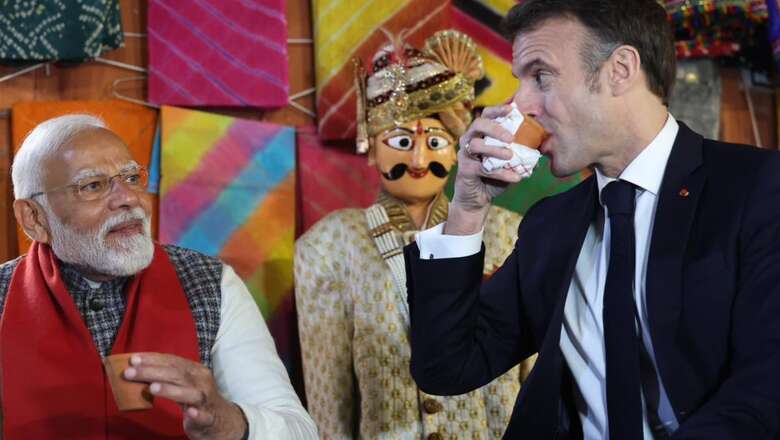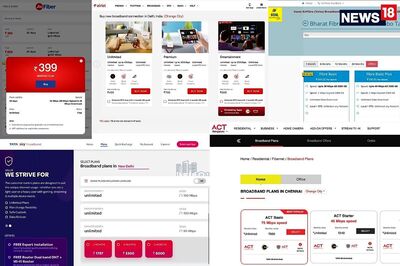
views
India is actively establishing a robust digital public infrastructure (DPI) ecosystem, not only on the domestic front, but also on a global scale. It is gaining recognition as a game-changer in India’s pursuit of achieving financial inclusion for its citizens.
According to an exclusive report by the Mint, the Indian government is now considering leveraging its lines of credit to offer digital public goods and infrastructure stacks to other developing countries. Spurred by the success of digital public goods and infrastructure such as CoWin (portal for Covid vaccination drive), and UPI (unified payments interface) at home, India wants to share the technology with emerging economies. “India hopes to develop partnerships, especially with the global south which is development-oriented, as well as demand-driven,” the person said, requesting anonymity.
Countries such as Ethiopia, Guinea, Sierra Leone, Sri Lanka and Togo have actively utilized or tested technologies and services from India’s DPI.
THE DIGITAL PUBLIC INFRASTRUCTURE
A robust digital public infrastructure (DPI) consists of distinct digital identification, a payments system, and a data exchange layer, holding the promise of driving economic transformation and fostering inclusive growth.
India’s foundational DPI, known as India Stack, has actively stimulated innovation and competition, playing a crucial role in expanding markets, bridging gaps in financial inclusion, enhancing government revenue collection, and optimizing public expenditure efficiency.
India’s experience in crafting a top-notch DPI actively guides other nations venturing into digital transformation. Notably, the emphasis on shared building blocks and supporting innovation across the ecosystem actively emerges as a pivotal design approach for the World.
In 2015, when Prime Minister Narendra Modi launched the Digital India initiative, its focus was to provide a digitally inclusive India. As a result, Government services have gradually been integrated into digital platforms, allowing for quick and efficient delivery at the grassroots level.
Aadhaar, bank accounts for all Indians, data exchange (account aggregators and DigiLocker) and the Unified Payments Interface (UPI) have today become a cornerstone of India’s digital public infrastructure.
A World Bank report from September 2023 hailed the success of India’s DPI to enhance financial inclusion and delivery of public goods and services. As a result of the Modi government’s DPI push, the World Bank claims India has achieved a “remarkable” 80 per cent financial inclusion rate.
LINES OF CREDIT
At the outset, it is the intertwining of India’s digital and economic diplomacy.
India’s DPI is a much sought after digital infrastructure and governance programme, and combining it with the LOCs provides India a chance to once again showcase its digital prowess and prove that its DPI is “for everyone”. Moreover, it will also bolster India’s tech and economic diplomacy.
Combining LoCs with DPI will also establish multiple channels of co-operation with existing partners. It will also allow those partners to modernise their governance model without the cost of investing heavily in R&D, which would have happened if they had started it from scratch. This also makes India’s LoCs more attractive and lucrative. In Africa, where India is second only to China in terms of investments, aligning DPI with the LoCs would make Indian funds irresistible. State-backed institutions such as The Exim Bank in India actively provide LOCs to overseas financial institutions, regional development banks, sovereign governments, and other overseas entities.
In addition to supporting the import of goods and services, the LOCs actively promote the exports of Indian products and services across various sectors, including agriculture, infrastructure, telecom, railway, transmission/power and renewable energy.
According to the External Affairs Ministry, India has so far offered 308 LOCs, worth about $32.02 billion, to various partners in Asia and Africa. These funds have supported more than 600 development projects in sectors such as infrastructure, power, connectivity and health across countries of the Global South. About $17.06 billion has gone to countries in Asia, $12.15 billion to those in Africa and $2.81 billion to countries elsewhere.
In Asia, New Delhi’s “Neighbourhood First” policy remains at play, as is evident from the grant assistance projects with countries such as Afghanistan, Bangladesh, Maldives, Myanmar, Nepal, Sri Lanka and Bhutan.
GOING GLOBAL
India’s digital infrastructure has caught the eye of the world, across continents.
Western nations such as France and Germany, along with many in South Asia and Africa, have also either shown interest or have started to use the India stack either as a pilot or running full-fledged. Even countries as far as Brazil are privately engaged to make use of India’s DPI.
UPI, launched in 2016, has certainly become the apple of the eye for many, including French President Emmanuel Macron. During his recent visit to India, he shared a cup of “kulhad tea” with PM Modi in Jaipur, the payment for it was made through UPI. Macron was vowed with the feasibility of payment and remembered to mention it in his speech at the official banquet hosted by President Droupadi Murmu for him at Rashtrapati Bhavan.
During PM Modi’s July visit to France, he announced that India and France have agreed to implement the UPI payment mechanism, starting with the iconic Eiffel Tower. Indian tourists in France will now have the capability to make payments in rupees.
A top government official informed News18 that “35-40 countries” are currently considering adopting UPI, with India actively engaging with them on the matter.
India has UPI-related bilateral agreements with Singapore, Australia, the United States (US), United Kingdom (UK), Canada, Hong Kong, Oman, Qatar, the United Arab Emirates (UAE), Saudi Arabia, Nepal and Bhutan. Since early 2023, Japan, too, has been evaluating the possibility of adopting India’s UPI system.
Apart from UPI, which is a gemstone of India’s DPI, eight countries have already signed Memoranda of Understanding (MoUs) with India for the India stack. Interest has been shown in adopting the payments and healthcare systems.
Armenia, Sierra Leone, Suriname, Antigua, Barbados, Trinidad and Tobago, Papua New Guinea, and Mauritius have all signed pacts that allow them to access the India DPI at no cost and with open-source access. These nations can now use these resources to develop their unique innovations.
The Pan African e-Network, Africa’s largest digital project, is actively connecting 54 African countries to India, enabling them to access expertise in telecommunications, medicine, health, resource mapping, and digital governance. In a significant move aimed at accelerating financial inclusion across Africa, the Indian government this year decided to contribute $2 million to the Africa Digital Financial Inclusion Facility (ADFI), managed by the African Development Bank.
In May 2023, the EU-India Trade and Technology Council, recognised the “importance of DPI for the development of open and inclusive digital economies”. The EU and India agreed to collaborate on enhancing the interoperability of their respective DPIs, using it as a foundation to promote secure privacy-preserving solutions for developing countries.
In the same month, the Quad Leaders’ Statement highlighted the “transformative power of …DPI to support sustainable development in the Indo-Pacific”. Additionally, the members of the Shanghai Cooperation Organization (SCO) unanimously endorsed India’s proposal to assist SCO member states in evaluating and adopting India Stack.
WHY GLOBAL REACH MATTERS
Surely, there are hundreds of tech giants emulating India’s DPI or have already been doing it for some time. But what India offers is an alternative to the tech giants-led, capitalist model and giving back the control of their digital journey to the people. Given their low cost and inherent scalability, there is much interest among other nations to explore the establishment of DPIs.
India’s DPI is “for everyone”. India’s digital frameworks such as MOSIP can be used by other countries. These tools are flexible and open, allowing nations to adjust and use them based on what they need. By sharing these tools, India helps other countries create their own digital systems that are fair and efficient.
And last but not least, it helps in speeding up the progress. It makes it easier for governments to provide services such as healthcare and education efficiently. Using technology in this way helps everyone access these services easily. Overall, it contributes to making countries better and more developed.
Moreover, developing nations widely acknowledge the fundamental value of DPI as an accelerator of the SDGs. In 2018, India established the Modular Open Source Identity Platform (MOSIP) to assist countries in constructing foundational digital identity systems. Presently, nine developing countries have collaborated with India through MOSIP, leveraging Indian expertise to develop their national ID platforms. This solidifies the position of DPI as a global digital public good.
LEADER OF A DIGITAL GLOBAL SOUTH
India, during its G20 Presidency last year, played a crucial role in showcasing the country’s DPI potential to the world, particularly to nations in the Global South. As India envisions a larger global role, the Modi government prioritises the high-mission of sharing its digital infrastructure model with the developing and underdeveloped world.
Recognising the transformative impact the India’s DPI model can have globally, the government has actively worked to share the ‘India Stack’ with numerous countries.
To facilitate the adoption of India’s DPI by countries aspiring to replicate it, the government is set to establish and manage a Global Digital Public Infrastructure Repository (GDPIR). This virtual repository of DPI will be made accessible for use by other G20 members and beyond.
Another initiative is the creation of a Social Impact Fund aimed at promoting the development of Social Impact Fund to advance Digital Public Infrastructure (DPI) in the Global South.
The 8 MOUs signed during the G20 last year and the interest shown by the African nations in India’s DPI is not just a testament to India’s digital growth, but also provides it a modern platform to be a leader of the global south.
During its G20 presidency, India also put forth the One Future Alliance (OFA) to build capacity, offer technical assistance and provide funding support for implementing DPI in LMICs. The OFA has the potential to aid developing countries in adopting DPI by delivering capacity-building programmes, sharing knowledge and expertise, and establishing an open-source solutions repository.
The high-level G20 Framework for Systems of DPI, which delineates principles for designing and deploying DPIs, is anticipated to become an indispensable tool as countries implement their DPI roadmaps.
In 2024, India will actively learn about how different countries are using DPI. India has the know-how to provide assistance to these countries by using its experience in cooperation and knowledge-sharing through MOSIP and MOU’s signed. With the inclusion of Lines of Credit in the equation, it is set to be another significant year for Indian diplomacy, driven by DPI.
As the world inches towards 2030, the proven impacts of DPI in terms of galvanising inclusive development, seamless public service delivery, and the digital economy, will become a fulcrum for advocacy, with India leading from the front.
Views expressed in the above piece are personal and solely those of the author. They do not necessarily reflect News18’s views.


















Comments
0 comment